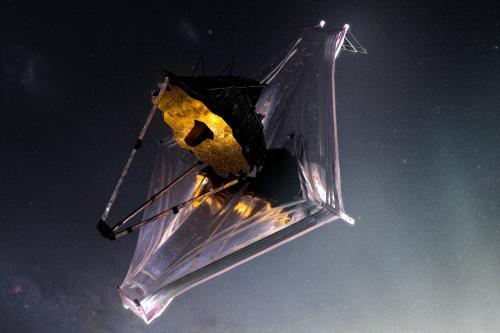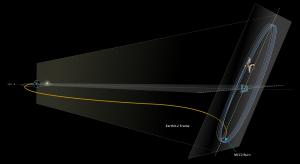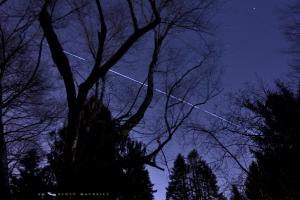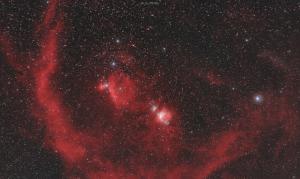Celebration of Space - January 28, 2022

An artist impression of the James Webb Space Telescope at its final destination, Lagrange 2. Image credit: Adriana Manrique Gutierrez/NASA
On Monday, January 24, 2022, the James Webb Space Telescope (JWST) fired its onboard thrusters for a period of nearly 5 minutes, increasing the travel speed of the observatory by 3.6 miles per hour, allowing for the observatory to successfully assume a halo orbit around the second Lagrange point. This is the final destination for the JWST, and its place of residency. Insertion into L2 is a huge milestone in the overall deployment of the telescope, and moves the observatory into its next stage configuration, the primary mirror alignment procedures.
The orientation of the telescope has the sunshade positioned between the telescope and the Sun / Earth, which will shield the temperature sensitive instruments from solar radiation. Even though the device is quite cold at this point, it will still take several weeks for the telescope to drop to the required operating temperature. Additionally, primary mirror segment alignment will take three months to complete, followed by calibration of the individual components. At this point we are on schedule for a sneak peek at first light images from the JWST this coming summer.
NASA has released a new 3D Solar System tool that shows where the James Webb telescope is in regards to the Solar System and the Terran System (Earth and Moon), as well as the position of other objects like the Hubble Space Telescope and the International Space Station. Additionally, you can compare the size of objects in the Solar System as well as compare the size of satellites against each other or other commonly known objects. So blow off your Friday afternoon and geek out with the new tool.
Evening passes of the International Space Station (ISS) continue this week, though passes will be less than spectacular for the next several nights due to passes occurring rather low over the horizon. Starting on February 1, 2022, passes will start to rise higher over the horizon. If you’re wondering why the ISS passes over our region at different altitudes, periods of the year, and times of the day, check out our article on Viewing the International Space Station. Here are a few notable passes for the coming week:
Sun, Jan 30 at 6:32 pm, starting n the NW, rising to 24°, and into orbital sunset
Mon, Jan 31 at 5:44 pm, staring in the NNW, rising to 19°, heading towards the ENE
Mon, Jan 31 at 7:21 pm, starting in the NW, rising to 20°, and into orbital sunset
Tue, Feb 1 at 6:33 pm, starting in the NW, rising to 48°, and into orbital sunset
Wed, Feb 2 at 5:45 pm, starting in the NW, rising to 32°, heading towards the E
Wed, Feb 2 at 7:21 pm, starting in the WNW, rising to 26°, and into orbital sunset
Thu, Feb 3 at 6:33 pm, starting in the WNW, rising to 62°, heading towards the SSE, and into orbital sunset. ← Awesome pass!
Though many of those ISS passes are not all that great, China’s space station – Tiangong will be putting on fantastic evening passes over our region this weekend and coming week! Here are several notable passes of Tiangong for this weekend and the coming week:
Fri, Jan 28 at 6:34 pm, starting in the WSW, rising to 50°, and into orbital sunset ← Awesome pass!
Sat, Jan 29 at 5:34 pm, starting in the SW, rising to 33°, heading towards the E
Sun, Jan 30 at 6:11 pm, starting in the WSW, rising to 71°, heading towards the E, and into orbital sunset ← Awesome pass!
Mon, Jan 31 at 6:48 pm, starting in the W, rising to 68°, and into orbital sunset ← Awesome pass!
Tue, Feb 1 at 5:48 pm, starting in the W, rising to 87°, heading towards the E, and into orbital sunset ← Awesome pass!
Wed, Feb 2 at 6:24 pm, starting in the W, rising to 89°, heading towards the E, and into orbital sunset ← Awesome pass!
Thu, Feb 3 at 7:01 pm, starting in the W, rising to 43°, and into orbital sunset
Pass times listed are applicable for Southern New England regions and are generally acceptable for the entire Northeast. For daily pass times of the stations, as well as other bright satellites over our region, visit the Frosty Drew Daily Satellite Pass Prediction Utility, which updates every day. Note that Tiangong is called “TIANHE” on our utility as that is the name of the current module that is in orbit. Tiangong will be comprised of three modules when it is completed. Tianhe is the first of the three modules that will be assembled in space.
On Monday, February 1, 2022 at 12:49 am EST the New Moon will occur. The new Moon is the best time to be out observing at locations like Frosty Drew Observatory, where there is minimal light pollution. This is because moonlight will significantly illuminate Earth’s atmosphere, making the atmosphere brighter than most dim stars, nebulae, star clusters, and the Milky Way galaxy. During the new Moon, the Moon will orbit in between the Earth and the Sun, with the opposite side of the Moon, the side we don’t see, in direct sunlight. Additionally, since the Moon is in between Earth and the Sun, the Moon will rise and set with the Sun, leaving the entire nighttime period moon free. The nights surrounding the new Moon are also spectacular opportunities to visit dark sky areas because the slender crescent Moon, which looks stunning, will set in evening twilight or rise in morning pre-dawn, leaving a good deal, if not most of the night in darkness. That means tonight would have been a fabulous night to host a Stargazing Night at Frosty Drew, but the weather has other plans.
Enjoy the snow!
- Author:
- Scott MacNeill
- Entry Date:
- Jan 28, 2022
- Published Under:
- Scott MacNeill's Columns




